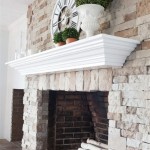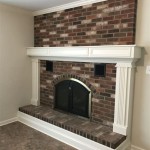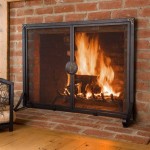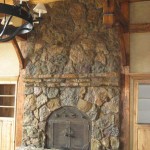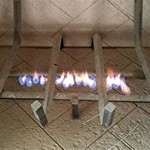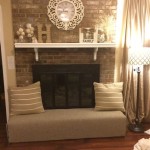Gas Fireplace Chimney Repair: Maintaining Safety and Efficiency
Gas fireplaces offer a convenient and aesthetically pleasing alternative to traditional wood-burning fireplaces. However, like any appliance connected to a chimney, they require regular maintenance and occasional repairs. Focusing specifically on the chimney component, this article will elaborate on the common issues, repair solutions, and preventative measures associated with gas fireplace chimneys. Proper chimney maintenance is crucial not only for the efficient operation of the fireplace but, more importantly, for the safety of the occupants by preventing carbon monoxide poisoning and potential fire hazards.
A gas fireplace chimney, while not subjected to the same creosote buildup as a wood-burning chimney, still faces unique challenges. The combustion process of natural gas or propane generates moisture and acidic byproducts that can corrode the chimney liner and other components. Furthermore, external factors such as weather and physical damage can contribute to the deterioration of the structure over time. Addressing these issues promptly and effectively is essential for maintaining the integrity of the system and ensuring safe operation.
Common Issues in Gas Fireplace Chimneys
Several factors can contribute to problems with gas fireplace chimneys. Understanding these issues is the first step in identifying and addressing potential repair needs.
Condensation and Corrosion: The primary culprit behind many gas fireplace chimney problems is condensation. When the flue gases cool as they rise through the chimney, water vapor condenses on the inner walls. This condensation, combined with acidic byproducts like sulfur dioxide, forms a corrosive mixture that attacks the mortar joints, flue liner, and metal components. Over time, this corrosion can weaken the chimney structure and create pathways for dangerous gases to leak into the home.
Damaged Flue Liner: The flue liner is a critical component of the chimney, designed to contain the combustion gases and protect the surrounding masonry from heat and corrosion. Liners can be made of various materials, including clay tiles, metal, or cast-in-place concrete. Cracks, gaps, or deterioration in the flue liner compromise its ability to safely vent the gases. These defects allow gases to infiltrate the chimney structure, potentially leading to carbon monoxide poisoning or damage to the building materials.
Blockages Although gas fireplaces produce minimal soot, the chimney can still become blocked by debris such as leaves, bird nests, or animal remains. These obstructions restrict airflow, causing the gases to back up into the house. A blocked chimney can also interfere with the proper draft, leading to incomplete combustion and increased carbon monoxide production. Regular chimney inspections and cleaning can help prevent blockages from occurring.
Structural Damage: External factors like weather conditions, ground settling, and physical impact can cause structural damage to the chimney. Cracks in the masonry, crumbling mortar, or leaning chimneys are signs of structural issues that need to be addressed promptly. Structural damage not only compromises the chimney's ability to vent gases safely but can also pose a safety hazard to the surrounding property and people.
Improper Installation: Incorrect installation of the gas fireplace or chimney system can lead to a variety of problems. Using incompatible materials, improper sizing of the flue, or inadequate venting can all contribute to inefficient operation and increased risk of hazards. It is paramount to ensure that the installation is performed by a qualified professional who is familiar with local codes and regulations.
Repair Solutions for Gas Fireplace Chimneys
The appropriate repair solution depends on the specific issue and the extent of the damage. A thorough inspection by a qualified chimney professional is essential to determine the best course of action.
Flue Liner Repair or Replacement: If the flue liner is cracked or damaged, it needs to be repaired or replaced. Small cracks can sometimes be repaired using a specialized sealant or patching material. However, if the damage is extensive, a new flue liner is necessary. Common options for flue liner replacement include stainless steel liners, which are durable and resistant to corrosion, or cast-in-place liners, which provide a seamless and airtight seal. The choice of liner depends on the specific requirements of the fireplace and the chimney's existing structure.
Chimney Relining: Relining is a process of installing a new flue liner inside the existing chimney. This method is often used when the original liner is severely damaged or deteriorated. A flexible stainless steel liner is typically used for relining gas fireplace chimneys. The liner is inserted into the chimney and connected to the fireplace and the chimney cap. Relining provides a safe and effective way to restore the chimney's functionality and protect the surrounding structure.
Mortar Repair and Tuckpointing: Deteriorated mortar joints can be repaired through a process called tuckpointing. This involves removing the old, crumbling mortar and replacing it with fresh mortar. Tuckpointing restores the structural integrity of the chimney and prevents water from penetrating the masonry. It helps to extend the life of the chimney and reduce the risk of further damage. Care should be taken to select a mortar mix that is compatible with the existing masonry.
Chimney Crown Repair or Rebuild: The chimney crown is the top portion of the chimney that protects the masonry from water damage. A cracked or damaged crown allows water to seep into the chimney, leading to deterioration and structural problems. Small cracks can be repaired with a sealant, but if the damage is extensive, the crown needs to be rebuilt. A properly constructed chimney crown should be sloped to direct water away from the flue and have an overhang to protect the sides of the chimney.
Chimney Waterproofing: Applying a waterproof sealant to the exterior of the chimney can help prevent water penetration and protect the masonry from freeze-thaw damage. A good waterproofing product should be breathable, allowing moisture to escape from the chimney while preventing water from entering. Waterproofing is a proactive measure that can extend the life of the chimney and reduce the need for future repairs.
Chimney Cap Installation or Repair: A chimney cap is a protective covering that prevents rain, snow, leaves, and animals from entering the chimney. It also helps to prevent downdrafts and improve the efficiency of the fireplace. A damaged or missing chimney cap should be replaced promptly to protect the chimney from the elements and potential blockages. Choose a cap that is made of durable materials and is properly sized for the flue.
Preventative Measures for Gas Fireplace Chimney Maintenance
Prevention is always better than cure. Implementing preventative measures can significantly reduce the risk of chimney problems and extend the life of the system.
Annual Chimney Inspections: Regular chimney inspections are crucial for identifying potential problems early on. A qualified chimney sweep can inspect the chimney for cracks, blockages, and other signs of damage. Early detection of issues allows for timely repairs, preventing them from escalating into more costly and dangerous problems. Inspections should be performed at least once a year, preferably before the heating season begins.
Regular Chimney Cleaning: Although gas fireplaces produce less soot than wood-burning fireplaces, the chimney can still accumulate debris and blockages. Regular cleaning removes any accumulated debris, ensuring proper airflow and preventing dangerous gases from backing up into the house. A chimney sweep can use specialized tools to clean the chimney and inspect for any potential problems.
Proper Ventilation: Ensuring adequate ventilation in the room where the gas fireplace is located is essential for safe operation. Proper ventilation provides a fresh air supply for combustion and helps to prevent the buildup of carbon monoxide. When operating the fireplace, ensure that windows or doors are slightly open to allow for air circulation. Install and maintain carbon monoxide detectors to alert you to the presence of dangerous levels of the gas.
Use of a Qualified Professional: Any work on the gas fireplace or chimney should be performed by a qualified professional who is licensed and insured. A professional has the knowledge and experience to diagnose problems accurately and perform repairs safely and effectively. Attempting to repair the chimney yourself can be dangerous and may void the warranty on the fireplace.
Monitor for Signs of Problems: Pay attention to any signs of problems with the gas fireplace or chimney. These may include unusual odors, smoke entering the house, or a decrease in the fireplace's efficiency. If you notice any of these signs, turn off the fireplace immediately and consult a qualified professional. Do not attempt to use the fireplace again until it has been inspected and repaired.
Proper Gas Fireplace Usage: Follow the manufacturer's instructions for operating the gas fireplace. Avoid using the fireplace for extended periods of time without proper ventilation. Make sure that the fireplace is properly maintained and serviced according to the manufacturer's recommendations. Using the fireplace correctly will help to prevent problems and ensure safe operation.
By understanding common issues, implementing appropriate repair solutions, and adopting preventative maintenance measures, homeowners can ensure the safe and efficient operation of their gas fireplace chimneys. Regular inspections, proper cleaning, and timely repairs are essential for protecting your home and family from the dangers of carbon monoxide poisoning and fire hazards. Consulting with a qualified chimney professional is always the best approach for addressing any concerns or issues related to your gas fireplace chimney.

Gas Fireplace Services Sunrise Chimney Service

How Much Maintenance Does A Gas Fireplace Need Vertical Chimney Care

What Makes Up A Fireplace Chimney Dc Area Repair Service

Flue Repairs And Chimney Relining A 1 Pro

Gas Fireplace Services For Your Home Safe Chimney In Seattle

Fireplace Maintenance For Wood And Gas Fireplaces Sierra Hearth Home

Best Gas Fireplace Service And Repair King Snoho Mk Home

Chimney And Fireplace Repair Flue Tech Inc

Fireplace And Stove Service Repair Chimney Sweep Services

Gas Fireplace Service Repair Frederick Md Installation
Related Posts


